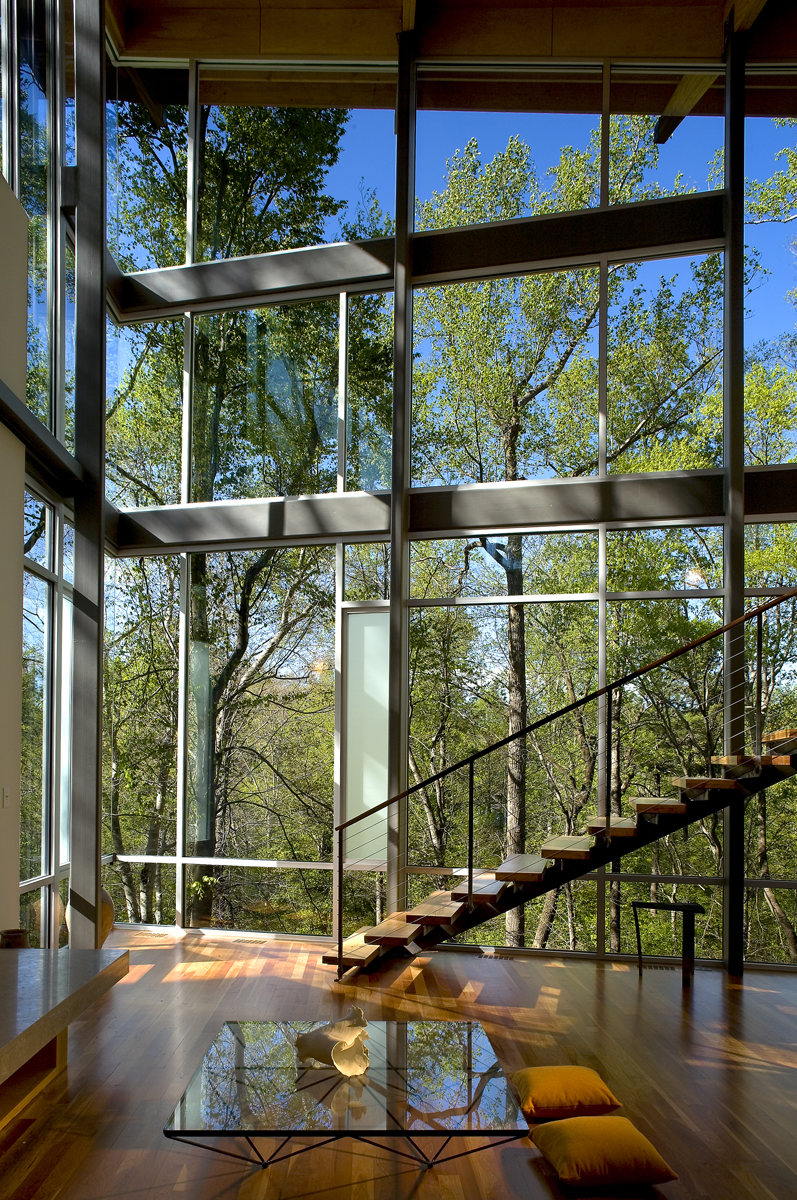






STRICKLAND - FERRIS RESIDENCE
Raleigh, North Carolina
2005
Frank Harmon, Sarah Queen
The house was designed primarily for one person who had three specific requirements: (1) she wanted “something dramatic;” (2) She wanted to feel “as if I’m living in the trees;” and (3) she wanted the house to be utterly devoid of unnecessary ornamentation to the point that she could see the marks of construction, from exposed bolts to the “unfinished” ceiling structure.
The site is a steep, north-facing escarpment 80 feet above Crabtree Creek, shaded by a then-150-year-old beech and oak forest. The creek has carved this escarpment for millions of years, which immediately suggested a site of great ecological sensitivity. We knew we had to build upon it carefully.
To give the owner a shelter that treads lightly on the sensitive site, we perched the house on nine, broad-shouldered wood trusses without cutting a single major tree. The trusses permit air and water to flow under the house, preserving the hydrology of the escarpment. We created a very large, butterfly-shaped roof to open views northwards to the creek and to funnel rainwater into a collection system on the south side.
The entrance to the house is a progression from the top of the hill, across a bridge, and into a balcony foyer, at which point the drama of the scenery outside fills the interior through two-story, floor-to-ceiling, north-facing glass walls. From the balcony, a graceful steel staircase with wooden treads descends past the glass (in essence, through the trees) to the dramatic, two-story-clear main living floor, which, in turn, opens onto a sunny and partially secluded south-facing terrace below the bridge.
At all times of the day, the house is filled with a view of nature and, by day, dappled light. Deep roof overhangs extend a visual link to the outside and shade the glass. Laminated wood columns and beams, plainly bracketed, strengthen the presence of nature, add an element of warmth to the interior, and echo the trees beyond. The roof beams reach out to the sky like tree limbs.
Careful arrangement of glazing, even on the more private, street-facing elevation, maintains a sense of transparency and delicacy. This is consistent throughout the interior: Partition walls between rooms stop short of reaching the exposed-wood ceiling and pocket doors between spaces feature “frosted” central panels in the spirit of shoji screens. The balcony-level floor includes the master bedroom suite. The main floor includes the living/dining space/kitchen space (open to each other), another full bathroom, and an additional cozy “bedroom” space that the owner uses as a media room.
The strength of the wood structure contrasts with the delicacy of the environment, framing the expanse of nature and contrasting it with the intimacy of the house. The structure of the house is parallel strand lumber, conserving forest resources. All framing and trim is locally harvested, southern yellow pine. From outside at night, the house appears as a fragile, luminous tent cradled by the forest.
Awards
2005 AIA NC Merit Award
2006 AIA Triangle Honor Award
2009 Custom Home Magazine Design Award, Gold Award
